Insect Borers of Trees and Shrubs
ENT-43: Insect Borers of Trees and Shrubs | Download PDF
by Daniel A. Potter and Michael F. Potter, Entomologists
University of Kentucky College of Agriculture
Wood-boring insects are among the most destructive pests of ornamental trees and shrubs. Most borers are the larvae (immature stages) of certain moths and beetles. They tunnel and feed under the bark in living wood, destroying water- and sap-conducting tissues. This causes girdling, branch dieback, structural weakness, and decline and eventual death of susceptible plants. Infestation sites also provide entry points for plant pathogens.
Clearwing and flatheaded borers are the main types that attack woody ornamentals. The groups differ somewhat in their habits and host preferences, which can affect the approach for controlling them with insecticides. The keys to controlling these pests are to keep plants healthy and, if necessary, to treat during those times of the year when the insects are vulnerable to insecticides.
Infestation and Damage
Borers rarely infest healthy plants growing in their natural environments. However, when trees or shrubs are transplanted into the landscape, stresses such as drought, soil compaction, sun scald, or injuries can weaken them and make them more susceptible to attack. Adults may locate suitable egg-laying sites by responding to volatile chemicals that emanate from stressed trees.
Adult borers emerge from infested trees in the spring or summer. After mating, the females fly to a suitable host and lay eggs on the bark, often in crevices or around wounds. Hatching occurs about 10 days to 2 weeks later. The young larvae quickly tunnel beneath the bark where they feed and grow. Once inside the tree, borer larvae are no longer vulnerable to insecticide sprays and are seldom detected until serious damage has been done.
Several species of clearwing and flatheaded borers can infest landscape plants. While some are attracted to a range of hosts, most attack only certain kinds of trees and shrubs. It is important to know when the adults of each species are active and which plants are vulnerable in order for treatment to be effective.
Clearwing Borers
Adult clearwing borers are delicate, day-flying moths that resemble small wasps. The moths feed only on nectar or not at all so they do not cause damage. The larvae are whitish, hairless caterpillars with brown heads. The most damaging clearwing borers are associated with dogwood, lilac, ash, oak, rhododendron, and ornamental Prunus species, including flowering peach, plums, and cherries.
Detecting Clearwing Borers
Early signs of clearwing borer infestation are wilting of terminal shoots, and branch and crown dieback. Infestation sites often are marked by cankers, calluses, or cracked bark. Large limbs may die or become so weakened that they are easily broken in the wind. Established trees may persist in poor condition and be re-infested year after year.
Clearwing borers expel coarse, brown frass (sawdust-like fecal material) from cracks in the bark. In some hosts, especially Prunus species, the frass may be mixed with oozing sap or gum. When the adult moth emerges, it leaves an empty, tan shell (pupal skin) that protrudes from the bark. Feeding holes left by woodpeckers or other birds may indicate that a tree is infested.
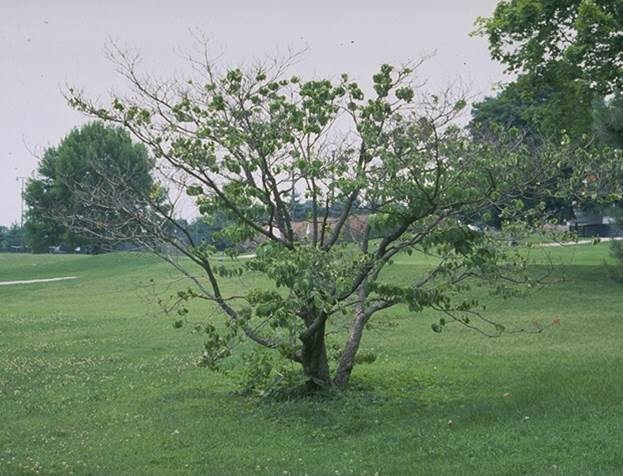
Figure 1a. Symptoms of clearwing borer infestation include crown dieback
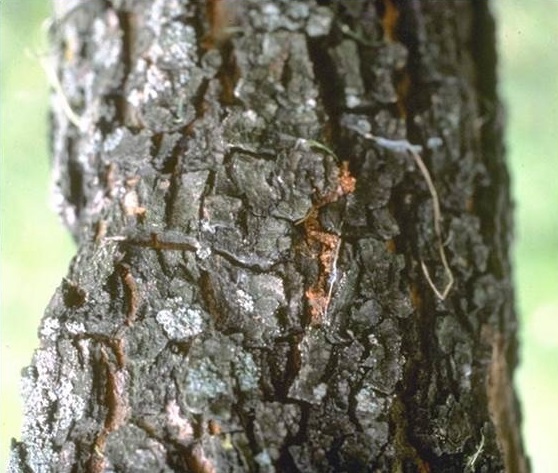
Figure 1b. Coarse, sawdust-like frass exuding from cracks in the bark from clearwing borer.
Insecticides for Clearwing Borers
Properly-timed bark sprays with contact insecticides can prevent infestation of susceptible trees and shrubs. Pyrethroids including bifenthrin (Onyx®, (Talstar®) and permethrin (Astro®) work well. Chlorantraniliprole (Acelepryn), is an effective, bee-friendly option. Chlorpyrifos (Dursban® 50W) can still be used in commercial nurseries. All of those products are contact insecticides that require proper timing in order to intercept newly hatched clearwing borer as they crawl over or tunnel into the bark. The trunk and main scaffold limbs should be sprayed to runoff but the foliage need not be sprayed.
Systemic insecticides, whether applied as injections or as soil treatments, generally have not given reliable control of clearwing borers.
Application Timing for Clearwing Borers
Table 1 includes a list of approximate treatment dates if spraying bark to protect trees from becoming infested by clearwing borers. These timing guidelines are based on several years of monitoring borer flight periods in Kentucky. These are average target dates; the best timing may vary from year to year depending on spring temperatures (i.e., earlier in warmer years, later in cool ones). Because plant and insect development are both temperature-dependent, using plant phenology (seasonal timing and sequence of bloom of so-called “indicator plants”) is often a more accurate scheduling tool than relying on calendar dates. Indicator plants whose blooming coincides with spray timing for particular borer species are listed in Table 1.
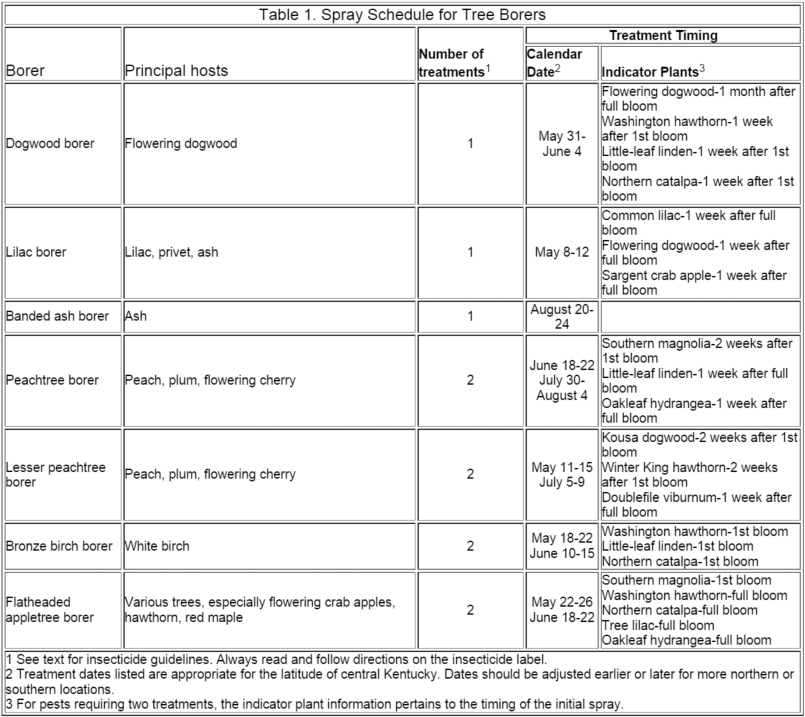
Sticky traps baited with lures containing synthetic sex pheromones are another way to fine-tune spray scheduling for borer control. These lures mimic the scent produced by the virgin female moth when she is ready to mate. Male moths detect the airborne scent from a considerable distance, and they follow the chemical trail upwind to its source. Hang the trap in a convenient tree or shrub in early spring, and check it weekly until flight begins. Apply your spray 10 to 14 days after the first males are caught, which will coincide with the beginning of the larval hatching period. This provides a protective residue that intercepts the young borers before they can tunnel through the bark. Apply a second spray if males are still being captured after 6 weeks.
Commercial trap kits come with several cardboard traps, instructions, enough bait to last a season, and picture keys for distinguishing the various captured borers. Some borers respond to particular baits, so when ordering traps, specify the borer or tree species that concerns you. [Pheromone traps are available from: Gempler's, www.gemplers.com (1-800-382-8473); Great Lakes IPM, www.greatlakesipm.com (989-268-5693).] Trapping does not increase risk of infestation because only males are attracted.
Types of Clearwing Borers
Dogwood borer, Synanthedon scitula, prefers flowering dogwood (Cornus florida) as its host. Infestations in young trees usually occur in the main trunk, often around lawn mower injuries. Infestations in older trees are likely to be higher up in limb crotches or main limbs and associated with pruning scars, cankers, or cracked bark. Dogwood trees planted in the sun are more susceptible than trees in the shade. Symptoms include dieback of branches and coarse, sawdust-like frass expelled from cracks in the bark. This insect species is widely distributed wherever dogwoods are cultivated.
Lilac borer, Podosesia syringae, is a pest of lilac, ash, and privet throughout the United States east of the Rockies. Most infestations occur from the root crown up to about 3 feet. This species begins to fly in late April or May.
Banded ash clearwing borer, Podosesia aureocincta, attacks only ash, especially green ash (Fraxinus pennsylvanica). The adults resemble lilac borers and may be monitored with the same pheromone lures, but they are active in August and September—well after the lilac borers' flight is finished.
Peachtree borer, Synanthedon exitiosa, and lesser peachtree borer, Synanthedon pictipes, are pests of peach, plum, cherry, and other Prunus species, including both fruit and ornamental varieties. Peachtree borer larvae attack mainly young trees, feeding under the bark from the root crown to about 2 feet above ground level. The lesser peachtree borer prefers older trees, infesting the upper trunk and main branches, often around wounds, cankers, or other damaged areas. Infestation sites are marked by accumulations of brown frass mixed with sap and gum.
Rhododendron borer, Synanthedon rhododendri, attacks rhododendrons and, occasionally, mountain laurel and flowering azaleas.

Figure 2a. Clearwing borer moths, such as this banded ash clearwing borer, resemble a stinging wasp.
Flatheaded Borers
Adult flatheaded borers are fast-moving, flattened, metallic-colored beetles with short antennae. Larvae are whitish, legless, and the first segment of their thorax is wide and flat just behind the head. They make winding tunnels beneath the bark, destroying phloem and cambium and girdling the trunk or branches. The tunnels may be visible externally as spiral ridges or cankers on the limbs or trunks. Unlike clearwing borers, which expel frass from cracks in the bark, flatheaded borers pack their fine, sawdust-like frass in their tunnels.
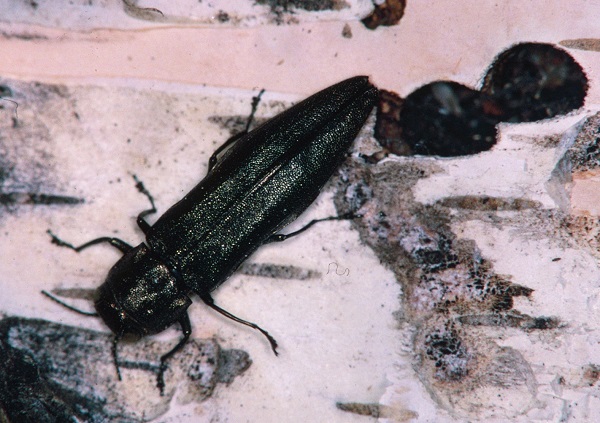
Figure 2b. Flatheaded borer adults, such as this bronze birch borer, are beetles
(Photo: Steven Katovich, USDA Forest Service, Bugwood.org)
Symptoms and Diagnosis of Flatheaded Borers
Adults emerge from infested trees in spring or summer through characteristic D-shaped holes. With some species (such as the flatheaded appletree borer), the bark becomes cracked or cankered at the site of attack. After mating, female borers emerge and lay their eggs on the bark of their preferred host trees. Unlike young clearwing borers, newly hatched flatheaded borers do not crawl over the bark in search of entry points. Instead, they chew directly into the tree through the bottom of the egg shell. Besides the D-shaped holes, symptoms include thinning and dieback of branches, usually starting in the upper 1/3 of the tree canopy, followed by eventual death of the tree.
Controlling Flatheaded Borers
Systemic insecticides applied via trunk injection, basal bark sprays, or as a soil drench are effective against flatheaded borers and they may be the only practical method for treating tall trees. Newly-transplanted ornamentals and nursery liners can be protected with properly-timed bark sprays of the same types of pyrethroids listed above for clearwing borers.
Types of Flatheaded Borers
Emerald ash borer (Agrillus planipennis) adults are distinctive dark metallic green beetles that are about 1/2 long and about 1/8 inch wide. This invasive insect, which has killed hundreds of millions of ash trees in North America, was discovered in Kentucky in 2009. The larvae feed on the inner bark of ash trees from June through October, disrupting the tree's ability to transport water and nutrients. Unless protected, infested trees usually die within 4 to 7 years of attack. All native ash species are susceptible to attack. The insect has been found recently in white fringetree (Chionanthus virginicus).
Ash trees can be protected from attack by this devastating insect by: 1)a systemic insecticides applied by soil injection or soil drench (dinetofuran, imidacloprid), 2) systemic injections applied as trunk injections (azadirachtin, emamectin benzoate, imidacloprid), or 3) a systemic insecticide applied as a lower trunk spray (dinetofuran). Options vary with tree size (diameter at breast height). Homeowners may use products that contain either dinetofuran or imidacloprid). See Insecticide options for protecting ash trees from emerald ash borer for detailed information on control options:
http://www.emeraldashborer.info/documents/Multistate_EAB_Insecticide_Fact_Sheet.pdf.
Bronze birch borer (Agrilus anxius) is a severe pest of white or paper birch in the landscape. Symptoms include twig and branch dieback starting in the upper 1/3 of the tree. With successive years of attack, the tree becomes progressively weaker until it is killed.
Dead or dying limbs will have numerous D-shaped adult exit holes, each about the size of a BB shot. Adult bronze birch borers are slender, olive-bronze beetles about ½-inch long. In Kentucky, adults begin emerging and laying eggs in mid-May.
The flatheaded appletree borer, Chrysobothris femorata, is a severe pest of small, stressed landscape trees, especially flowering crab apples, hawthorns, and maples during the first year or two after they are transplanted. This borer may attack almost any hardwood tree that is stressed by defoliation, sun scald, drought, soil compaction, or mechanical injury. It makes broad winding tunnels under the bark, destroying the phloem, cambium, and outer xylem. The full-grown larva is about an inch long, legless, and yellow-white. A single borer can girdle and kill a small tree.
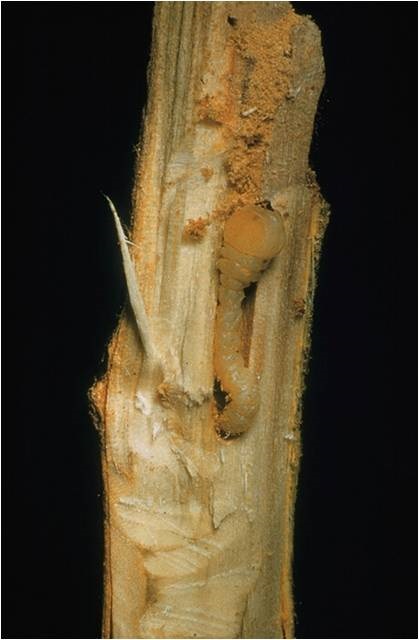
Figure 3. The flatheaded appletree borer larva makes winding tunnels beneath the bark, destroying the phloem, cambium, and outer xylem and girdling the trunk of young trees.
The adult beetle is flattened, about ½-inch long, bronze-colored above, and brassy underneath. It leaves a large, 3/16-inch, D-shaped hole when it emerges from the tree. The adults emerge and begin to lay eggs in late May or early June in Kentucky.
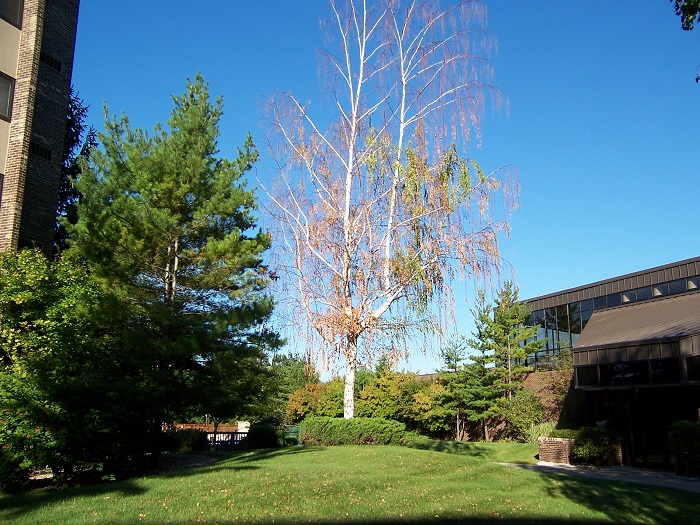
Figure 4a. Symptoms of bronze birch borer attack include crown dieback
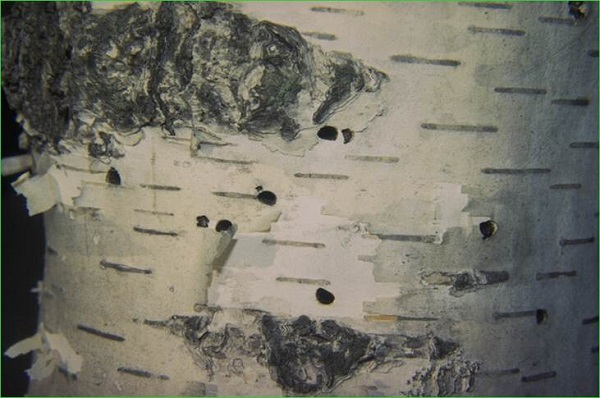
Figure 4b. D-shaped holes left by the adult bronze birch borer beetles as they emerge from limbs or trunks.
Preventive Management for Borers
Stressed trees and shrubs tend to be more susceptible to borer infestation, so plant health care is a first line of defense:
- Do not plant ash trees; because of emerald ash borer it is no longer a suitable landscape plant.
- Avoid planting native understory species such as dogwoods and rhododendrons in full sun.
- Select well-adapted cultivars for your region.
- Use proper planting methods. Transplanted trees and shrubs need extra water until they become established.
- Control other pests that contribute to tree stress.
- Be careful not to wound the bark when mowing or using a string trimmer. Fresh trunk wounds are attractive to egg-laying adult borers.
- Avoid tree wraps – they may encourage borer attacks by delaying proper hardening of the bark.
- Inspect susceptible tree species regularly for the telltale symptoms, and apply insecticides only during those periods when borers are vulnerable.
Mention or display of a trademark, proprietary product or firm in text or figures does not constitute an endorsement and does not imply approval to the exclusion of other suitable products or firms.
Revised: 4/16
CAUTION! Pesticide recommendations in this publication are registered for use in Kentucky, USA ONLY! The use of some products may not be legal in your state or country. Please check with your local county agent or regulatory official before using any pesticide mentioned in this publication.
Of course, ALWAYS READ AND FOLLOW LABEL DIRECTIONS FOR SAFE USE OF ANY PESTICIDE!
Images: Dan Potter, University of Kentucky Entomology except bronze birch borer adult: Steven Katovich, USDA Forest Service, Bugwood.org
